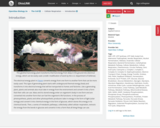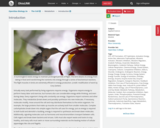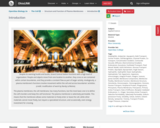549 Results

By the end of this section, you will be able to do the following:
Discuss the fundamental difference between anaerobic cellular respiration and fermentation
Describe the type of fermentation that readily occurs in animal cells and the conditions that initiate that fermentation
- Subject:
- Applied Science
- Material Type:
- Module
- Date Added:
- 09/21/2018
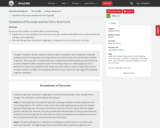
By the end of this section, you will be able to do the following:
Explain how a circular pathway, such as the citric acid cycle, fundamentally differs from a linear biochemical pathway, such as glycolysis
Describe how pyruvate, the product of glycolysis, is prepared for entry into the citric acid cycle
- Subject:
- Applied Science
- Material Type:
- Module
- Date Added:
- 09/21/2018
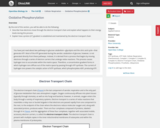
By the end of this section, you will be able to do the following:
Describe how electrons move through the electron transport chain and explain what happens to their energy levels during this process
Explain how a proton (H+) gradient is established and maintained by the electron transport chain
- Subject:
- Applied Science
- Material Type:
- Module
- Date Added:
- 09/21/2018
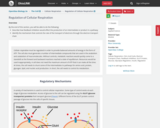
By the end of this section, you will be able to do the following:
Describe how feedback inhibition would affect the production of an intermediate or product in a pathway
Identify the mechanism that controls the rate of the transport of electrons through the electron transport chain
- Subject:
- Applied Science
- Material Type:
- Module
- Date Added:
- 09/21/2018
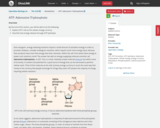
By the end of this section, you will be able to do the following:
Explain ATP's role as the cellular energy currency
Describe how energy releases through ATP hydrolysis
- Subject:
- Applied Science
- Material Type:
- Module
- Date Added:
- 09/21/2018
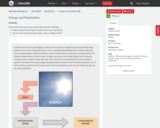
By the end of this section, you will be able to do the following:
Explain metabolic pathways and describe the two major types
Discuss how chemical reactions play a role in energy transfer
- Subject:
- Applied Science
- Material Type:
- Module
- Date Added:
- 09/21/2018
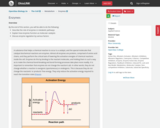
By the end of this section, you will be able to do the following:
Describe the role of enzymes in metabolic pathways
Explain how enzymes function as molecular catalysts
Discuss enzyme regulation by various factors
- Subject:
- Applied Science
- Material Type:
- Module
- Date Added:
- 09/21/2018
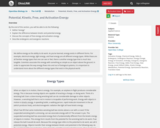
By the end of this section, you will be able to do the following:
Define “energy”
Explain the difference between kinetic and potential energy
Discuss the concepts of free energy and activation energy
Describe endergonic and exergonic reactions
- Subject:
- Applied Science
- Material Type:
- Module
- Date Added:
- 09/21/2018
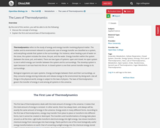
By the end of this section, you will be able to do the following:
Discuss the concept of entropy
Explain the first and second laws of thermodynamics
- Subject:
- Applied Science
- Material Type:
- Module
- Date Added:
- 09/21/2018
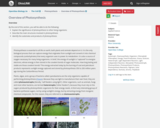
By the end of this section, you will be able to do the following:
Explain the significance of photosynthesis to other living organisms
Describe the main structures involved in photosynthesis
Identify the substrates and products of photosynthesis
- Subject:
- Applied Science
- Material Type:
- Module
- Date Added:
- 09/21/2018
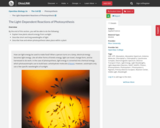
By the end of this section, you will be able to do the following:
Explain how plants absorb energy from sunlight
Describe short and long wavelengths of light
Describe how and where photosynthesis takes place within a plant
- Subject:
- Applied Science
- Material Type:
- Module
- Date Added:
- 09/21/2018

By the end of this section, you will be able to do the following:
Describe the Calvin cycle
Define carbon fixation
Explain how photosynthesis works in the energy cycle of all living organisms
- Subject:
- Applied Science
- Material Type:
- Module
- Date Added:
- 09/21/2018
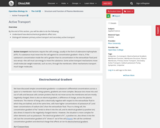
By the end of this section, you will be able to do the following:
Understand how electrochemical gradients affect ions
Distinguish between primary active transport and secondary active transport
- Subject:
- Applied Science
- Material Type:
- Module
- Date Added:
- 09/21/2018
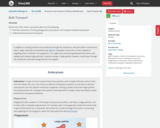
By the end of this section, you will be able to do the following:
Describe endocytosis, including phagocytosis, pinocytosis, and receptor-mediated endocytosis
Understand the process of exocytosis
- Subject:
- Applied Science
- Material Type:
- Module
- Date Added:
- 09/21/2018
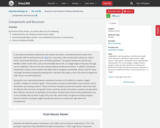
By the end of this section, you will be able to do the following:
Understand the cell membrane fluid mosaic model
Describe phospholipid, protein, and carbohydrate functions in membranes
Discuss membrane fluidity
- Subject:
- Applied Science
- Material Type:
- Module
- Date Added:
- 09/21/2018
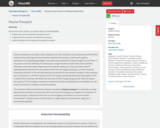
By the end of this section, you will be able to do the following:
Explain why and how passive transport occurs
Understand the osmosis and diffusion processes
Define tonicity and its relevance to passive transport
- Subject:
- Applied Science
- Material Type:
- Module
- Date Added:
- 09/21/2018
